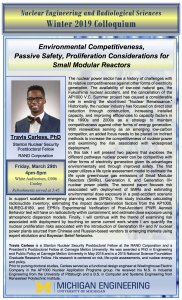Presented By: Nuclear Engineering & Radiological Sciences
NERS Colloquium: Travis Carless, RAND Corporation
Environmental Competitiveness, Passive Safety, Proliferation Considerations for Small Modular Reactors

Speaker: Travis Carless, RAND Corporation
Abstract: The nuclear power sector has a history of challenges with its relative competitiveness against other forms of electricity generation. The availability of low-cost natural gas, the Fukushima nuclear accident, and the cancellation of the AP1000 V.C. Summer project has caused a considerable role in ending the short-lived “Nuclear Renaissance.” Historically, the nuclear industry has focused on direct cost reduction through construction, increasing installed capacity, and improving efficiencies to capacity factors in the 1990s and 2000s as a strategy to maintain competitiveness against other forms of energy generation. With renewables serving as an emerging low-carbon competitor, an added focus needs to be placed on indirect methods to increase the competitiveness of nuclear power and examining the risk associated with widespread deployment.
In this talk I will present two papers that explores the different pathways nuclear power can be competitive with other forms of electricity generation given its advantages environmentally and through improved safety. The first paper utilizes a life cycle assessment model to estimate the life cycle greenhouse gas emissions of Small Modular Reactors (SMRs), Generation II, and Generation III+ nuclear power plants. The second paper focuses risk associated with deployment of SMRs and estimating environmental dose exposure in a post-accident scenario to support scalable emergency planning zones (EPZs). This study includes calculating radionuclide inventory; estimating the impact decontamination factors from the AP1000, NUREG-6189, and EPRI’s Experimental Verification of Post-Accident iPWR Aerosol Behavior test will have on radioactivity within containment; and estimate dose exposure using atmospheric dispersion models. Finally, I will continue with the theme of examining risk associated with deployment by touching on some current work where I am quantify the nuclear proliferation risks associated with the introduction of Generation III+ and IV nuclear power plants sourced from Chinese and Russian-based vendors to emerging markets using expert elicitation and Bayesian Belief Networks.
Bio: Travis Carless is a Stanton Nuclear Security Postdoctoral Fellow at the RAND Corporation and a President’s Postdoctoral Fellow at Carnegie Mellon University. He was awarded a PhD in Engineering and Public Policy at Carnegie Mellon University in May 2018 and is a 2015 National Science Foundation Graduate Research Fellow. His research is centered on risk, life-cycle assessments, and nuclear energy and policy.
Prior to pursing doctoral studies, Carless served as a functional design engineer at Westinghouse Electric Company in the AP1000 Nuclear Application Programs group. He received his M.S. in Industrial Engineering from the University of Pittsburgh and a B.S. in Computer and Systems Engineering from Rensselaer Polytechnic Institute.
Abstract: The nuclear power sector has a history of challenges with its relative competitiveness against other forms of electricity generation. The availability of low-cost natural gas, the Fukushima nuclear accident, and the cancellation of the AP1000 V.C. Summer project has caused a considerable role in ending the short-lived “Nuclear Renaissance.” Historically, the nuclear industry has focused on direct cost reduction through construction, increasing installed capacity, and improving efficiencies to capacity factors in the 1990s and 2000s as a strategy to maintain competitiveness against other forms of energy generation. With renewables serving as an emerging low-carbon competitor, an added focus needs to be placed on indirect methods to increase the competitiveness of nuclear power and examining the risk associated with widespread deployment.
In this talk I will present two papers that explores the different pathways nuclear power can be competitive with other forms of electricity generation given its advantages environmentally and through improved safety. The first paper utilizes a life cycle assessment model to estimate the life cycle greenhouse gas emissions of Small Modular Reactors (SMRs), Generation II, and Generation III+ nuclear power plants. The second paper focuses risk associated with deployment of SMRs and estimating environmental dose exposure in a post-accident scenario to support scalable emergency planning zones (EPZs). This study includes calculating radionuclide inventory; estimating the impact decontamination factors from the AP1000, NUREG-6189, and EPRI’s Experimental Verification of Post-Accident iPWR Aerosol Behavior test will have on radioactivity within containment; and estimate dose exposure using atmospheric dispersion models. Finally, I will continue with the theme of examining risk associated with deployment by touching on some current work where I am quantify the nuclear proliferation risks associated with the introduction of Generation III+ and IV nuclear power plants sourced from Chinese and Russian-based vendors to emerging markets using expert elicitation and Bayesian Belief Networks.
Bio: Travis Carless is a Stanton Nuclear Security Postdoctoral Fellow at the RAND Corporation and a President’s Postdoctoral Fellow at Carnegie Mellon University. He was awarded a PhD in Engineering and Public Policy at Carnegie Mellon University in May 2018 and is a 2015 National Science Foundation Graduate Research Fellow. His research is centered on risk, life-cycle assessments, and nuclear energy and policy.
Prior to pursing doctoral studies, Carless served as a functional design engineer at Westinghouse Electric Company in the AP1000 Nuclear Application Programs group. He received his M.S. in Industrial Engineering from the University of Pittsburgh and a B.S. in Computer and Systems Engineering from Rensselaer Polytechnic Institute.